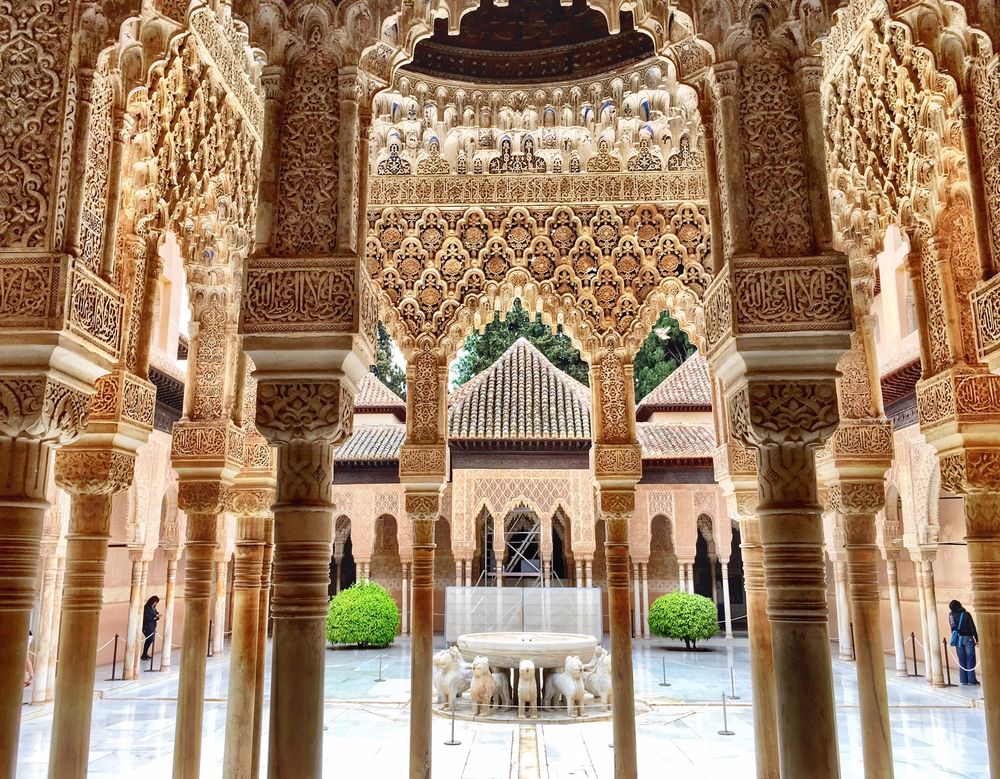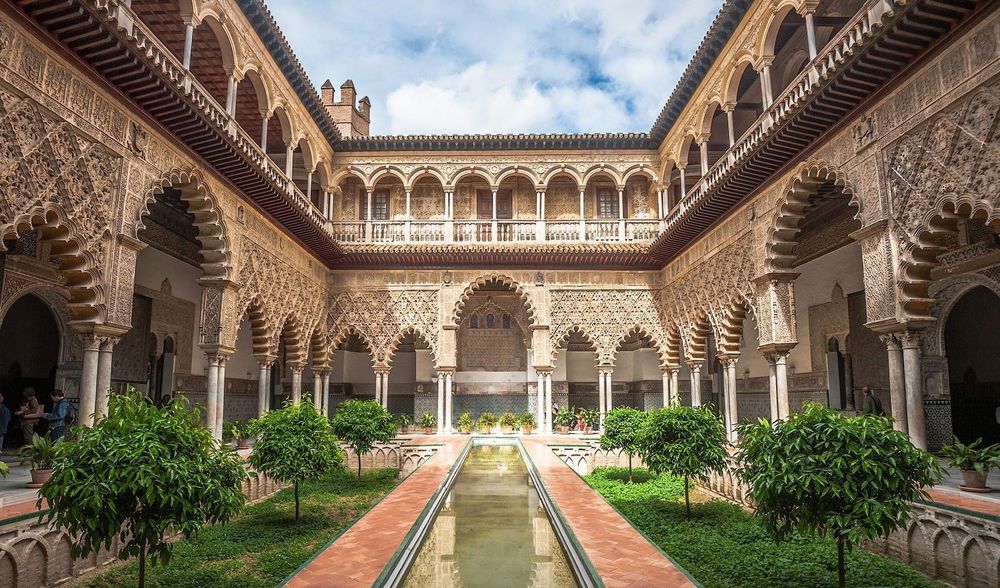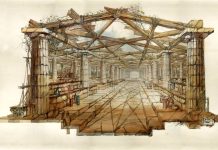“As we walk into the Alhambra, I’m immediately struck by the reflective power of the water. It seems as though the palace is built on water. Tiny little streams run from one fountain to another. The architecture of the palace already demonstrates a vertical symmetry: the left side of the façade is perfectly reflected in the right side. Standing at one end of the pool in the Courtyard of the Myrtles, one sees another perfect copy of the building reflected horizontally in the surface of the water. This vast expanse of water stretches to the very feet of the columns of the façade, and the palace and its reflection combine to give the impression of a crystal suspended in the sky. Some girls thrust their hands into the water, trying to touch the fish swimming there, and the symmetry is destroyed. It doesn’t take much to disturb the water’s calm surface and fragment the palace’s mirror image. That is the message in the water: perfect symmetry is hard to obtain. The natural world knows that. The Moorish architects loved the symbolism of the fragility of the symmetry in the water. The tension between the eternal nature of God and the transience of our fragile earth was captured by the dialogue between the solid symmetry of the palace and its elusive reflection in the pool.”
This description belongs to Marcus du Sautoy, a distinguished Professor of Mathematics at the University of Oxford. Du Sautoy is an expert in group theory and in number theory, which is increasingly revealed as the narrative of his most recent visit in Alhambra progresses:
“The walls of the palace are covered with tiles of different colors arranged to make patterns. There is a rhythm created by the symmetry which almost makes the walls pulsate, giving the effect of a moving image, hinting at the infinite expanse of the space … This is another reason why the Muslim artists were drawn to symmetry: as an artistic expression of God’s infinite wisdom and majesty … Hiding behind each tiling pattern is one of only seventeen different varieties of symmetry that is possible on a two-dimensional surface. We can look at the array of different shapes that the artists dreamt up and wonder whether they thought there was no end to the catalogue of symmetries…. It would be another five hundred years before mathematicians proved for certain that the medieval Moorish artists would never have been able to squeeze an eighteenth type of symmetry out of the tiles on the walls.”
The Alhambra Palace in Granada, Spain is situated on a plateau, on the top of a small hill that rises over the Darro River. Initially, it was a small citadel of the Muslim Moorish rulers of tenth-century Andalusia, which was expanded in several phases. The construction of its most famous sections began around 1330, when the town hall of Siena was nearly completed. It was known as “a pearl set in emeralds” and was praised by poets—not unduly, because it was a real paradise, green and with running water in a dry and warm land. The entire complex is enclosed by a wall from which thirteen towers loom, which contributed to the palace’s defense but also provided the opportunity to enjoy the view. The large park stretching on its foot was planted by the Moors with myrtles, orange trees, and roses, and was watered by an aqueduct that drew water from Darro before its descent into the valley.


The twelfth-century philosopher and astronomer Abu-l-Walid Muhammad ibn Rushd, who was known in the West as Averroes, came from Andalusia. He was among the most prolific and influential of Aristotle’s medieval commentators, continuing a centuries’ old tradition. In his era, a large number of ancient Greek texts on logic, cosmology, astronomy, medicine, and mathematics had already been translated to Arabic. In the following centuries, European students of the Greek classical texts turned for guidance to the commentaries of the Arabs translators; Averroes’ commentary on Physics, On the Heavens and other works by Aristotle were translated into Latin—the European lingua franca of that time—a few years after his death in 1198. Euclid had been translated into Arabic in the late ninth century; in fact, the first translation of this work into Latin was made from Arabic in the twelfth century. The earliest translations into Latin of several works by Aristotle, Galen, Ptolemy and Archimedes were also made from their Arabic versions.
The Arabs, along with their Persian contemporaries, made major developments in ancient Greek science. Among their achievements, they laid the foundations for algebra on the basis of ideas developed by Indian mathematicians, and they also made significant progress in optics. Their advanced knowledge and their love of mathematics and physics contributed greatly to the advancement of Islamic architecture and art—as can especially be seen at the Alhambra and in other masterpieces, from Fez to Esfahan and from Samarkand to Delhi.
Geometry was repeatedly employed to illustrate the cosmic order and to recreate it in our world. The rectangular domed structures, for instance, have probably visualized the creation of the multiplicity (our world) from the One (God), the primordial unity represented by the dome unfolding into the quadrature represented by the isotropic three-dimensional cubic structure beneath it. Moreover, Muslim architects and artists turned to geometry in order to create abstract images with which to decorate their buildings, since Islam is especially skeptical toward representation of living beings.

The application of mathematics in architecture and arts occurs more or less in every region of the world and every cultural context. The ancient Egyptians, as we know, often used the elementary geometrical shape of the pyramid—with very particular size ratios—for some of the most important buildings they constructed: the tombs of several pharaohs and high-ranking officials. Some of the most famous ancient Greek sculptors produced statues with strictly predetermined proportions in the body limbs’ sizes and invested their practice with a full-fledged theory. Several centuries later, Vitruvius conveyed to us that the Dorian, Ionian, and Corinthian orders represented the male and female genders and young girls, respectively. Therefore, the buildings that were built in these styles were constructed on the basis of different proportion systems: the Dorian order was more robust with ratio of height to columns’ diameter smaller than that of the Ionian order; the Corinthian order had the most delicate proportions, corresponding to the virgins’ grace and beauty. On the other side of the world, in the Indian subcontinent, the proportions of the moldings and friezes and tiers on Hindu temples were also strictly prescribed—the list is virtually endless.
The social status of architects has varied greatly during the course of history, and it was not unusual—as was the case in classical Greece— that their trade was considered to some degree vulgar, unlike, for example, music or rhetoric. In this context, mathematics offered architecture more important services than just providing assistance in solving practical design problems: it helped to upgrade it. Mathematics always excited peoples’ imagination; the notion that this abstract system, founded only in axioms, could describe in a simple and explicit way, the laws governing the seemingly chaotic complexity of the world, was “fascinating,” and the people who knew their secrets enjoyed respect.
Architects quite often resorted to geometry and to specific numerical ratios to configure and decorate their buildings in order to bestow them with prestige and beauty: prestige, since the affinity of the produce of architecture with the creations of God or Nature would supposedly be manifested; beauty, since something of the World’s harmony could be transferred to the buildings. Is this not also the case with music from the time of Pythagoras, who discovered that harmonic sounds were produced from chords whose lengths have simple numerical relations between them?
In the West, architects regularly incorporated simple numerical ratios in their buildings. Prime numbers were imbued by philosophers and occultists with metaphysical qualities in line with a tradition of eastern or Pythagorean origin, until at least the seventeenth century. In many instances, the first integers were considered to correspond to structural units of the universe; some other numbers—such as 6, 10, 256—were regarded for various reasons to express perfection. Rather less frequently, architects in the West used simple geometric shapes, such as circles, quadrangles, or octagons. Geometry itself had a special place in cosmology: Plato believed that “God is always doing geometry” and that the world—spherical in shape, since the circle is the perfect shape—consists of the five regular solids corresponding to earth, water, air, fire, and ether. Aristotle had vigorously opposed this point of view and Averroes had written a lengthy commentary on this topic, which was later translated into Latin. Buildings incorporating simple numerical ratios and geometrical shapes would reputedly confirm, just by being there, that the Universe is structured according to secret laws expressed with prime numbers and elementary geometry: a self-fulfilled prophecy that would cause the admiration of a public passionately seeking the hidden meaning of things. Rarely, though, would it gain the respect of philosophers or mathematicians who probably saw in such application of mathematics the excessive simplification, if not the trivialization, of elaborate concepts.
In Islam things were a bit different. Architects and artists adopted the Greco-Roman tradition of using proportions in their designs—the Great Mosque of Damascus is typical. However, they mainly used geometry, developing a design philosophy applicable in smaller as well as in larger objects, from carpets to mosques. It can be summarized as using simple geometrical shapes—quadrangles, rhombuses, circles, cubes, hemispheres—inscribed with highly complex smaller units.
According to a widespread view, which was also shared by several philosophers and theologians in the West, the perfection of the geometrical shapes reflected the perfection of the creations of God Himself, even if, according to Averroes, the Supreme Being did not have unlimited free will, and governed the world not with the arbitrariness of an absolute ruler, but through a structure of necessary causes which He had decreed Himself. The way that mathematics—especially geometry—was founded perfectly matched this cosmological perception. Building on a long Sufi tradition, the great master Ibn Arabi, who too came from Andalousia, and was a generation jounger than Averroes (whom he met in his youth), also used geometry extensively to illustrate his cosmology.
The extremely complex symmetries like those we encounter on the walls and floors of the palace of Alhambra corresponded to the world as understood by Averroes, or by the Sufis. They matched even more with the so-called occasionalist approach of many orthodox Muslim theologians and philosophers, who rejected the Aristotelian idea of an eternal world and endorsed Democritus’ view that matter is not eternal and immutable, but it consists of particles that meet and bind together. In this process, they argued, God intervenes changing the world according to His will. If, therefore, even today specialists are often unable to discern in Alhambra (as well as in other works of Islamic art) the mathematical structure of complex geometric decorative motifs and architectural members—which however present high regularity—then it is certain that in the eyes of a layperson several hundred years ago, these would have seemed to correspond to works of a power with the ability to mix the ingredients of matter at will producing, nevertheless, perfect results.
The occasionalist worldview was formulated around 1000 CE and was adopted by Caliph Al-Qadir, the leader of the Sunni Muslims based in Baghdad. It coincided with the invention—possibly in Baghdad as well—of maybe the most characteristic feature of Islamic architecture, the muqarnas. The muqarnas are small-scale corbelled brackets and niches forming concave three dimensional segments mainly used in zones of transition from flat to curved surfaces and for the decoration of the soffits of arches and vaults. They were possibly devised as an answer to a difficult design problem that architects faced—joining a hemispherical dome with a square hall. The typical solution, the squinch, probably dates back to Iran of the early Sassanid era—the dynasty that ruled the country from 224 until 651 CE—long before the advent of Islam. Squinches are the three-dimensional structures at the corners of the square hall beneath the hemispherical dome. Insofar as the dome symbolizes the sky, these visible supports did not coincide with the explicit assurance of the Qur’an4 that the sky is not supported anywhere. Muqarnas, on the other hand, made the domes appear as if they were suspended in air. Moreover, neither the clarity of the contour of the classical hemispherical dome, nor its smooth surface matched the complexity of the world according to the occasionalist approach of the orthodox theologians of Islam. But the adornment of the entire dome with muqarnas could visualize it instead. The dome was now deconstructed in small but distinct units arranged in a visually complex manner, which with their protrusions and recessions gave the impression that they were held together by an invisible hand.
The muqarnas were not only used in mosques, but in buildings of every kind—indeed an early example appears in the ninth century in private residencies in what is now Iraq—and not only in domes but in capitals, where again there is the problem of joining the cylindrical shaft with the arch above. This suggests that we are facing a rather typical case where architecture and ideology met halfway for reasons of mutual benefit. A nascent ideology—the occasionalist view of the world—adopted one element, the muqarnas, with which the architects were experimenting at the time. The occasionalists supported its dissemination; appropriating architecture’s power ideology would become more attractive and increase its discernment in the public. On the other hand, architecture gained prestige with the allegation that its creations and the world at large were governed by the same set of laws.
In Alhambra, the art of muqarnas reached a peak. Exceptionally designed and crafted, they give buildings a completely airy feel, in absolute harmony with the fragile calmness of the large water surfaces. In combination with the sounds of water running from small fountains and with the breeze cooling the shady covered areas arranged around the successive courtyards creating conditions of comfort for its inhabitants, they make the palace seem as if it were built from the material dreams are made of.
This is perhaps what makes the Alhambra palace a masterpiece: the sense that what the assignors and the architects attempted to convey with the broad use of mathematics is universally perceived even today, and indeed complements rather than destroys other qualities of architecture. One need not be a mathematician or a philosopher to gain the impression, wandering the halls and the courtyards of the palace that the perfection there is based in an almost incomprehensibly complex arrangement. Nor does one need to be king to appreciate the tranquility and beauty that prevails everywhere one turns his/her gaze.
Although the use of mathematics in architecture is, as discussed above, very common, it very rarely achieved what was accomplished in Alhambra. In the course of history, there have been attempts to transfer music harmony to buildings—e.g., by making the relative position of architectural members correspond to musical intervals. This would supposedly suffice to accomplish what German philosopher and poet Johann Wolfgang von Goethe summarized in his famous quote: architecture is congealed music.5 Goethe’s dictum, though, probably should not be taken at face value, but understood as a metaphor. The application of the laws governing musical harmony to architecture may well end up being a mind game, which cannot be perceived by the senses to which it is allegedly addressed. It is not at all self-evident that a rhythmic alternation of architectural members in space will be perceived in a manner similar to a melody, where the notes succeed one another in time. On the contrary, it is quite probable that some other properties of these architectural members—size and weight, the texture of their surfaces, their conservation status—will dominate the image obtained by the observer and will overshadow the fact that they are placed at distances proportional to the musical intervals of a melody.
Today, architecture once again resorts to mathematics in order to create forms. Some architects use advanced software to design in a mathematically consistent manner (which is essential for statics and construction) irregular forms that have emerged from their imagination. Others set only a few parameters, and the computer program creates quite unpredictable forms—the result of this parametric design is bestowed the exceptional prestige of the higher mathematics that produced it.
In both cases, while the architects assign a large part of their role as creators of forms to software—i.e., mathematics—they seem reluctant to relinquish their most fundamental right: to decide themselves which of the thousand alternative forms generated by the computer is worthy of further work, or which of these forms deserves to be built. The architects’ judgment in these fundamental issues remains primarily based on the most old-fashioned aesthetic criteria mixed with a sense of what constitutes a welcomed novelty or, instead, a low-profile proposal, appropriate for an environment dominated by posh neighboring buildings.
This behavior of architects is not contradictory. They know that the criteria with which a building is judged now and in the future—by people from one or another cultural background, by the public as whole, as groups, or as individuals, winter or summer, day or night, after a tiring day or in the weekend, in times of prosperity or recession—are too complex to be replaced by whatever clever mathematical functions that the software uses to generate a form.
The architects of Alhambra used mathematics precisely to achieve the perfect result. Let’s keep them in mind when we turn on our computers in order to design.



















